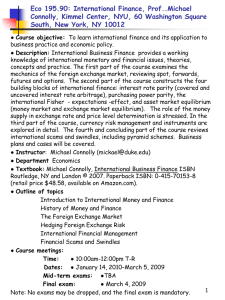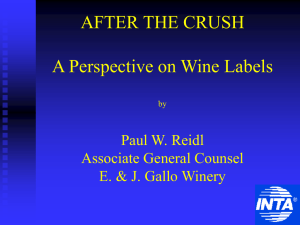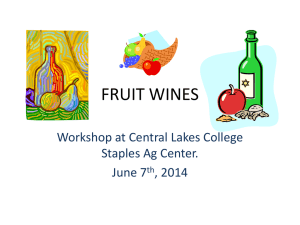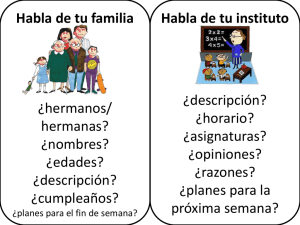Document
advertisement
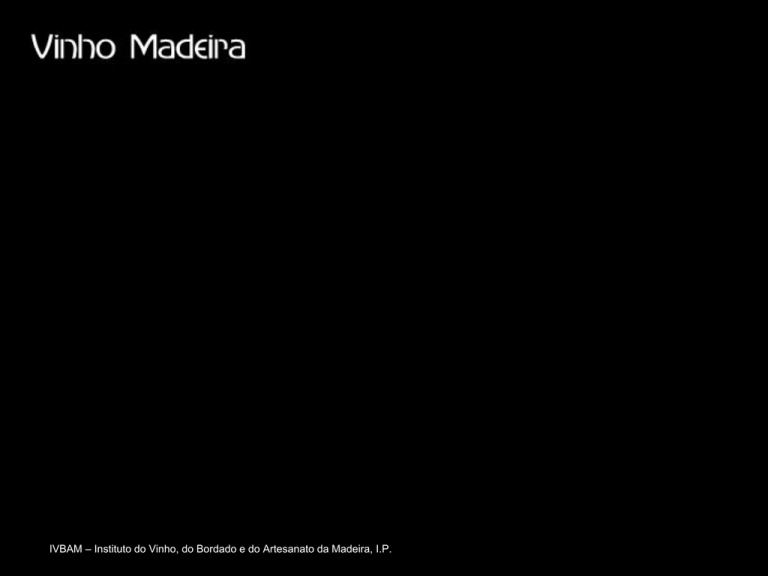
IVBAM – Instituto do Vinho, do Bordado e do Artesanato da Madeira, I.P. Rich and impressive colours ranging from amber to golden, aromas creating a luxurious and harmonious bouquet: vanilla, caramel, curry, dried fruit, figs, cinnamon… Unique flavours arising from a fascinating island in the Atlantic sharing its name with a wine: Madeira! IVBAM – Instituto do Vinho, do Bordado e do Artesanato da Madeira, I.P. Madeira Island IVBAM – Instituto do Vinho, do Bordado e do Artesanato da Madeira, I.P. History of Madeira Wine - Madeira Island discovery in 1419; - After colonisation, soils were cultivated with wheat, vines and sugarcane; - Historical records: 25 years after colonisation, the island was already exporting Madeira Wine; - More than five centuries of existence; - Most diverse export routes: Europe, Indies, Americas; - “Vinho da Roda” – boat trips to India, wines reached high temperatures passing through tropics improved wine quality; - From nineteenth century, the vast majority was exported to Europe - England, France and Scandinavian countries - and Japan; - Episodes: the celebration of the independence of the United States of America in 1776, which was commemorated with a toast made with Madeira Wine! - Symbolic examples: George Washington and Thomas Jefferson, profoundly knowledgeable on Madeira Wine; - Winston Churchill, got to know and enjoy this Wine during his visits to the island. IVBAM – Instituto do Vinho, do Bordado e do Artesanato da Madeira, I.P. Madeira, the Island - Situated between latitudes 35º and 45º north and longitude 17º west, 1100 Km from the coast of Portugal, the country to which it belongs, and 600 Km from the African coast; - Total surface area of 740Km2, with its highest point being Pico Ruivo, with an altitude of 1861 metres; - Wine-growing landscape deeply rooted in the island portrays a myriad of colours which change from different shades of green to reddish browns throughout the year; - Construction of terraces, sustained by stone walling, is reminiscent of staircases which in some parts of the island rise from the sea into the hills, as if they were gardens embedded in the landscape. IVBAM – Instituto do Vinho, do Bordado e do Artesanato da Madeira, I.P. Wine-Growing Region - Approximately 500 hectares; - Volcanic soil origin, mainly basalt; - Proximity to the sea; - Climatic conditions of hot, humid summers and mild winters; - Characterised by very sharp slopes called “poios”; - Irrigation water captured from highest areas of the island, conducted through canals called “levadas”; - Most traditional system is “latada” (trellised vine), laid out horizontally; - Introduction of espalier vines with gentler slopes on twentieth century. IVBAM – Instituto do Vinho, do Bordado e do Artesanato da Madeira, I.P. Vine Varieties - Most traditional grape varieties are: Sercial Verdelho Boal - There others recommended and authorized. IVBAM – Instituto do Vinho, do Bordado e do Artesanato da Madeira, I.P. Malvasia Tinta Negra Vine Varieties - Can be differentiated by its high acidity and astringency; - Essentially cultivated in the North of the Island and in Câmara de Lobos at altitudes up to 600 metres along the southern coast and up to 200 metres in the North; Sercial - Produces dry wines. - Produces slightly more full bodied and less acidic wines than those made from the Sercial variety; - Cultivated at an altitude of approximately 400 metres; Verdelho - Produces off-dry wines. - Great balance between acidity and sweetness; - Cultivated at latitudes varying from 100 to 300 metres; - Semi-sweet, medium bodied and rich. Boal IVBAM – Instituto do Vinho, do Bordado e do Artesanato da Madeira, I.P. Vine Varieties - First to be planted in the island, originated from Crete; - Generally found at altitudes of 150 to 200 metres; - Produces sweet wines, being amongst the richest and smoothest of Madeira wines. Malvasia - Essentially cultivated in the South of the Island, in Funchal and Câmara de Lobos and in the North in São Vicente; Tinta Negra - Tinta Negra produces Dry, Off-Dry, Semi-Sweet and Sweet wines, and accounts for 80 to 85% of total production. IVBAM – Instituto do Vinho, do Bordado e do Artesanato da Madeira, I.P. Vinification Process - Grapes are triaged for sanitary conditions; - Weighed and probable degree of alcohol verified; -Selection of grapes made in accordance with the type of wine to obtain; -Must is subjected to fermentation, partial or total; -Fortification with addition of vinous alcohol at 96% Vol., interruption done in accordance with the degree of sweetness desired; -Four types of wine may be obtained: dry, medium dry, medium rich and rich wines. IVBAM – Instituto do Vinho, do Bordado e do Artesanato da Madeira, I.P. Vinification Process Harvest Transport No skins Reception Pressing De-skinning Must Fermentation Fortification (vin. alc. 96%) Must + skins Fermentation Blending Pressing Estufagem Blend Filtration Canteiro IVBAM – Instituto do Vinho, do Bordado e do Artesanato da Madeira, I.P. Bottling Single harvest With skins Ageing Ageing Ageing “Estufagem” The wine is placed in inox stainless steel vats that are heated via a serpentine method. Hot water, at a temperature between 45 and 50 degrees Celsius, runs through this serpentine system for a period of never less than three months. Once the “estufagem” is completed, the wine is subjected to a period of “estágio” or let rest for at least 90 days in order to acquire the conditions that will make it possible for the oenologist to finish the wine so that it may be placed in a bottle with the required quality guarantee. These wines may never be bottled and commercialised before the 31st October of the second year following the harvesting and are typically batch wines. “Canteiro” The wines that are selected to age in “Canteiro” (this denomination comes from the fact that casks are placed on wooden support beams called “canteiros”) are aged in casks, usually in the top floors of the wine cellars, where the temperature is higher, for a period of two years. It has a type of oxidative ageing in the cask, making the wine develop unique characteristics of intense and complex aromas. “Canteiro” wines may only be commercialised once at least three years have elapsed, counting from the 1st January of the year following the harvest. IVBAM – Instituto do Vinho, do Bordado e do Artesanato da Madeira, I.P. Aromatic Evolution Primary aromas Citrus Floral Tropical Fruit Pine Burnt Hazelnuts Eucalyptus Dried fruit Chocolate Cinnamon Orange zest Lacquer Coffee Tobacco Nutmeg Red Fruit Cacao Toffee Tea Honey Brown sugar Oak Pepper Cloves Hay Quince jam Vanilla IVBAM – Instituto do Vinho, do Bordado e do Artesanato da Madeira, I.P. Dry Fruit Chocolate Spices Honey Tropical Fruit Laquer Ageing 3-hydroxy-4,5dimenthyl-2(5H)furanone Sotolon Types of Madeira Wine - year of harvest - indication of age - production process - degree of richness - colour - structure IVBAM – Instituto do Vinho, do Bordado e do Artesanato da Madeira, I.P. Year of harvest Frasqueira or Vintage - 100% of the grapes from the same harvest; -100% of the grapes of an only vine variety (recommended or authorised); -or of the mixture of recommended and/or authorised vine varieties with a minimum ageing of twenty years with outstanding organoleptic characteristics; -indication of year of harvest, the date of bottling and should be registered in a specific book entry. Colheita - 100% of the grapes from the same harvest; -100% of the grapes of an only vine variety (recommended or authorised); -or of the mixture of recommended and/or authorised vine varieties with a minimum ageing of five years with outstanding organoleptic characteristics; -indication of year of harvest, the date of bottling and should be registered in a specific book entry. IVBAM – Instituto do Vinho, do Bordado e do Artesanato da Madeira, I.P. Year of harvest Solera -outstanding organoleptic characteristics; -ageing must have been in “canteiro” for a minimum period of five years; -basis of a batch from which a quantity that must not exceed 10% is taken out of each cask every year for bottling, being replaced by an equal quantity of another wine of the same quality up to a maximum of ten additions, after which all the existing wine may be bottled at one time; -always indicate year of harvest as that of the first wine that is the basis to the batch and should be registered in a specific book entry. IVBAM – Instituto do Vinho, do Bordado e do Artesanato da Madeira, I.P. Indication of age Common to all: -organoleptic characteristics in conformity with typical quality standards for the age in question; -may have indication of vine variety name; -should be registered in a specific book entry. Seleccionado Rainwater =3<5 -maximum age indication five years -colour between golden and half golden -bulk density = or < 1,0150 g/ml 5 yo or Reserve =5<10 10 yo or Special Reserve or Old Reserve =10<15 IVBAM – Instituto do Vinho, do Bordado e do Artesanato da Madeira, I.P. 15 yo or Extra Reserve =15<20 20 yo =20<30 30 yo =30<40 >40 yo Degree fo richness Extra dry Dry Medium dry IVBAM – Instituto do Vinho, do Bordado e do Artesanato da Madeira, I.P. Medium sweet Sweet Other designations: Colour: - Very pale; - Pale; - Golden; - Medium dark; - Dark. Structure: - Light; - Full-bodied; - Fine; - Soft; - Velvety; - Mellow. IVBAM – Instituto do Vinho, do Bordado e do Artesanato da Madeira, I.P. Madeira Wine Certification Viticultural Laboratory: - Accredited Laboratory, in accordance with the NP EN ISO/IEC 17025 referential – General Requirements for the Competence of Testing and Calibration Laboratories”; - Official Vitivinicultural Laboratory of the RAM; - Laboratory assay and testing for certification. Tasting Panel: - 10 or more oenologists or other persons of renowned and undisputed competence in the area of oenology, - Test the wines at the sensorial level; - Through binding advisory report concerning possible commercialisation, ensure their quality and genuinity. IVBAM – Instituto do Vinho, do Bordado e do Artesanato da Madeira, I.P. Madeira Wine Institute -Supervise and control commercialisation of wines; production and - Implement registration of fermentation, distilling, rectification, preparation and storage facilities; - Establish current accounts for inputs, outputs and stocks; -Collect samples of wine to be analysed; - Issue lead seals and certificates of origin. IVBAM – Instituto do Vinho, do Bordado e do Artesanato da Madeira, I.P. Madeira Wine Foodmatching A vast repertoire of gastronomic combinations is possible with Madeira Wine and varying according to the degree of sweetness of the wine. The more refreshing dry wines may accompany smoked fish or sushi, while the sweeter wines combine perfectly with dried fruit, honey cake, dark or milk chocolate. Off-dry wines are excellent with consommé and French onion soup au gratin, or even duck or goose foie gras, whereas semi-sweet wines blend well with cheese soufflé or wild berries. Unforgettable cocktails may also be made with Madeira Wine…. The associations are IVBAM – Instituto do Vinho, do Bordado e do Artesanato da Madeira, I.P. delicious and infinite. Discover more.



